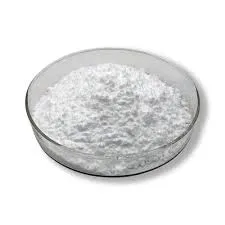
Dec . 12, 2024 11:36 Back to list
hydroxypropyl methyl cellulose cas no
Hydroxypropyl Methyl Cellulose (HPMC) An Overview
Hydroxypropyl methyl cellulose (HPMC) is a widely used non-ionic, water-soluble polymer that belongs to the family of cellulose ethers. With the Chemical Abstracts Service (CAS) number 9004-65-3, HPMC boasts a diverse range of applications across multiple industries, including pharmaceuticals, food, construction, cosmetics, and personal care. This article will delve into the properties, applications, and benefits of HPMC, highlighting its significance in various sectors.
Properties of Hydroxypropyl Methyl Cellulose
HPMC is derived from cellulose, a natural polymer obtained from plant cell walls. The modification process involves introducing hydroxypropyl and methyl groups into the cellulose structure, which enhances its solubility in both hot and cold water. This unique chemical modification gives HPMC several important properties
1. Water Solubility HPMC can dissolve in cold or hot water, forming a clear gel. This property is crucial for many applications, as it allows for easy incorporation into formulations without compromising their clarity or consistency.
2. Viscosity HPMC solutions exhibit a wide range of viscosities, depending on the concentration and the degree of substitution. This makes it highly adaptable for varied applications, from providing thickening in sauces to forming a smooth paste in pharmaceuticals.
3. Film-Forming Capability HPMC can create a flexible, transparent film when dried, making it valuable in coatings and as a binder in tablets.
Applications of HPMC
The versatility of HPMC allows it to serve numerous functions across different industries
1. Pharmaceuticals In the pharmaceutical sector, HPMC is widely used as a binder in tablet formulations, controlled-release agents, and a coating material. Its ability to modulate drug release rates makes it a preferred choice for sustained-release medications.
hydroxypropyl methyl cellulose cas no

2. Food Industry HPMC acts as a thickening agent, emulsifier, and stabilizer in various food products. It is commonly found in sauces, dressings, and gluten-free products, enhancing texture and consistency while improving shelf life.
3. Construction In the construction industry, HPMC is used in dry-mix mortars, tile adhesives, and plasters. It enhances workability and water retention, improving the overall performance of building materials.
4. Cosmetics and Personal Care HPMC is a popular ingredient in cosmetic formulations, including creams, lotions, and gel products. Its film-forming properties contribute to a smooth application, while also enhancing product stability.
5. Agriculture HPMC can be employed as a soil conditioner and as an additive in crop protection products, improving nutrient delivery and soil structure.
Advantages of Using HPMC
The use of HPMC offers several advantages, including
- Non-Toxicity HPMC is non-toxic and environmentally friendly, making it suitable for use in products intended for consumption or contact with human skin.
- Versatility Its range of properties allows manufacturers to tailor formulations for specific needs, resulting in better performance and consumer satisfaction.
- Stability HPMC has a long shelf life and retains its properties over time, ensuring consistent performance in formulations.
- Cost-Effectiveness HPMC is relatively cost-effective compared to other thickening and binding agents, adding to its appeal in various industries.
In conclusion, hydroxypropyl methyl cellulose (HPMC) stands out as a versatile and valuable ingredient across multiple sectors. From pharmaceuticals to food and construction, its unique properties facilitate a wide array of applications, making it an indispensable component in modern formulations. As industries continue to evolve, the demand for HPMC and its derivatives is likely to grow, reaffirming its role as a crucial polymer in diverse applications.
-
Versatile Hpmc Uses in Different Industries
NewsJun.19,2025
-
Redispersible Powder's Role in Enhancing Durability of Construction Products
NewsJun.19,2025
-
Hydroxyethyl Cellulose Applications Driving Green Industrial Processes
NewsJun.19,2025
-
Exploring Different Redispersible Polymer Powder
NewsJun.19,2025
-
Choosing the Right Mortar Bonding Agent
NewsJun.19,2025
-
Applications and Significance of China Hpmc in Modern Industries
NewsJun.19,2025







